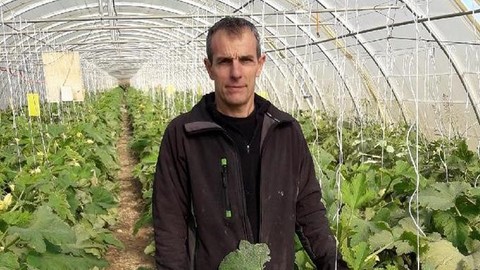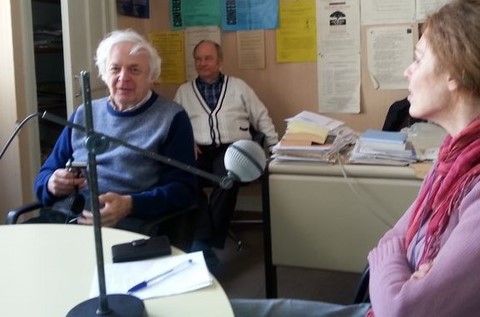zucchinis saved by music

Music can treat and even cure plants. It seems that some meticulously selected melodies have the capacity to inhibit the growth of viruses and molds and to stimulate plant growth. At least, according to the testimony of a French vegetable grower, Gilles Joshuan.
He runs a zucchini monoculture. Ten earss ago, his whole crop was contaminated by the mosaic virus. « There is no known method to fight against this scourge, » he says, adding that in his despair he had tried everything. He wouldn’t resign himself to uproot all his plants, which was the only solution advised by conventional agriculture. "I chanced upon the site of this company, Genodics, which proposed plant treatments by the way of protein music ! I had nothing to lose, so I tried it ! » confides this owner of 40 hectars in greenhouse and 50 hectars in the open air. «As soon as I started broadcasting music in the greenhouses, I could notice a difference. But the most difficult part was to spread out the music in plastic tunnel greenhouses with a high hygrometric level. » To solve this problem, the Genodics company foresees installations self-powered by solar panels and adapted to these tunnel conditions. «After some preliminary adjustments, we were able to save the zucchinis. At this time, the virus is still present but it is inhibited by the music and there is not a trace of it in the zucchini plants. I am therefore able to market them.»
In order to attain this spectacular reseult, he is applying to the dot the protocole established by the company. Every night, he broadcasts between 5 and 7 minutes of a specialy targeted music, «but no longer, otherwise the plants get tired" says the man, who harvests between 600 and 700 tons of zucchini a year. His yields arouse envy. His neighbors, who were at first amused by his methods, are now developing a close interest for them. «Some of my neighbors question me about my production methods and they are thinking of applying them to their own cultures. » He is convinced that it is a good idea, provided that a music is created which will be adapted to the cultivated produce.
In fact, Genodics explains that it is necessary to find melodies which are adapted to each pathology. « In the case of Gilles Josuan, at the beginning, we had identified only one virus, then it turned out that there were.two at work. Having discovered this, we were able to adapt the melody and to inhibit both viruses, which weaken the plants but remain harmless to man », explains Pedro Ferrandiz, the co-founder of Genodics which uses musical vibrations to fight againt the diseases of certain plants (molds, viruses, bacterias…...), which makes it possible to limit the use of pesticides.
Protéodie is the name of the science which is supposed to be at the origin of these surprising results. « To put it simply, during the process of protein synthesis, amino acids emit the vibrations of musical notes, so that every protein emits a specific melody, » explains the head engineer of Genodics. «One must get to know the protein involved in the pathology one wants to fight against, isolate it and find out the song of the protein so as to be able to stimulate or inhibit its synthesis. » He says that he is applying the theories of French physicist Joël Sternheimer, who had a career as a pop singer in his youth.
Genodics role is to identify, then to decipher the score of the protein! Its techniques have helped over 130 growers of fruit or vegetables to fight against pathologies which threaten their production.
For instance, a fruit tree grower of Saint-Féliu-d'Avall, in the East Pyénées, was able to fight against the sharka virus by means of two musical broadcastings a day. The musical sequences with their therapeutic virtues helped reduce the mortality of peach trees. The same process made it possible to treat tomato plants infected hit by botrytis – a mold responsible for grey mold, and apple-trees affected by scab. But he main customers of Genodics are wine growers. Therapeutic melodies have been able to fight mildew, which is a mold, or esca, a mushroom parasites which decimates vineyards, especially in France.
The protocole remains the same: a broadcasting of music harmonized so that every vineplant can profit from the notes. Results are on the order of the day. « It is working systematically, but with results which vary between rates of 25% to 95%. For instance, results are spectacular on Cabernet, but are a bit less so on Alsace wines. On average, the success rate is around 70%», maintains Pedro Ferrandiz.
These experimental results had compelled the scientific community to lend an ear. Genodics entered in a partnership with the university of Cergy, in the Paris region, in order to make tests and to better understand the scientific mechanisms which might be at work. INRA (Institut National de Recherche Agronomique) recognizes that « plants are sensitive to sound and they react to some noises, such as the wind, or the cracking of a neighboring plant drying up, and these provoke a reaction. But as of today, theses relations have not been proven scientifically, » Bruno Moulia, research director at INRA points out. As for the theory on which Genodics is basing itself, «I cannot say that it does not work, but neither have we been able to demonstrate the efficiency of these treatments. » In order to know more, the institute would have to carry on experiments, which INRA is now considering doing. Results are the best argument!
Mathilde Golla, Le Figaro, Nov. 13, 2017
Translated from the French by Anne-Marie de Grazia
Joel Sternheimer

"Birds sing for the flowers, too. It is not for nothing that they appear together during evolution. They had something to say to each other..."
Joel Sternheimer
Joel Sternheimer was born on January 1943 in Montluel, in France. His father was killed at Auschwitz. In 1966, age 23, he obtained a 3rd Cycle Doctorate in Theoretical Physics at the University of Lyon. He garnered another diploma in Theoretical Physics at Princeton University where he became the asistant of Eugene Wigner but funding was scrapped because of the Vietnam War. Sternheimer returned to France in time for the May 1968 upheavals, and started a career as a pop singer, under the name of Evariste. He self-produced a single called La Révolution against the consumer society (one of the first ever self-produced records in France - no commercial record company would touch it because of its political contents) and sold it at an extremely low price (3/4 of a US dollar at the time) "to show how record producers fatten themselves." The record sold very well in the streets and Sternheimer cashed in on any earnings beyond the production costs, it brought him financial security and allowed him later on to finance his own independent research. He enjoyed the support of mathematician André Lichnerowicz and became in 1985 a scientific adviser at the Cité des Sciences de l'Industrie et de la Technique at La Villette, which is also the seat of the Cité de la Musique.
"At the interface between subject and object, the genodic code allows one to analyze a musical inspiration in molecular terms, then to construct the protéodie which is apt at regulating a physiological problem. To the 20 amino-acids which constitute proteins correspond, after they hook up onto their transfer ARN, 10 synchronized sequences whose succession of intervals during the elongation process has a functional role. These extensions of the de Broglie wave in order to satisfy to the homogeneity criteria required by taking into account the measuring subject according to quantum theory, persist in this 10 synchronized sequences effect well beyond their association with particles during this process. Resonance phenomena proceed from it, bearing on the time and space succession of intervals of synchronized frequencies, and regulate the rate of synthesis and the spatial refolding of the proteins. The invariance in scale of these successions of intervals then permits a form of dialogue between the subject and his genes, of which artistic inspiration has been a witness through the ages."
Wine and music
His research of 40 years has shown that the various levels of organization of matter (inert or living) are connected by way of “scale waves” which secure their coherence. During the process of protein synthesis, amino-acids emit sequences of quantic signals which constitute a melody specific to each protein. Audible transpositions of these melodies can act upon the rate of synthesis of these proteins.
Particularly adapted to grape vines, this music helps them to better defend themselves against the “wood diseases” or mildew, but it can also stimulate their resistance to freezing in spring, or to hydric stress in summer. The broadcasting equiment must be set up in strategic location, the music regulated so that ever plant is able to "hear" it… Thanks to a chosen repertory of 5 to 10 minutes broadcasting two to four times a day, the musical séance produces its little effect: the winegrower can reduce the volume of pesticides he uses and notices an improvement in the appearance of the vine stock, and in the quality of the grapes. In order to improve the taste of the wine, music can also “lull it” during the fermentation process. The diffusion of these melodies directly in the cellars stimulates the enzymes which transform the sugar into alcohol. Music can also intervene at the end of the process as is done in the Jura mountains, (for the fermentation of the vin jaune, "yellow wine"). After it is put in an open cask, the contact between the wine and air triggers the formation of a “veil of yeast.” This critical stadium allows the wine to get enriched in complew aromatic components. If the veil doesn’t form rapidly enough, the wine oxydates and volatile acidity increases. Quantic vibrations at this stage stimulate the multiplication of yeasts and their positive and durable influence on the quality of the wine.
France-Culture radiostation (5/15/2017)

